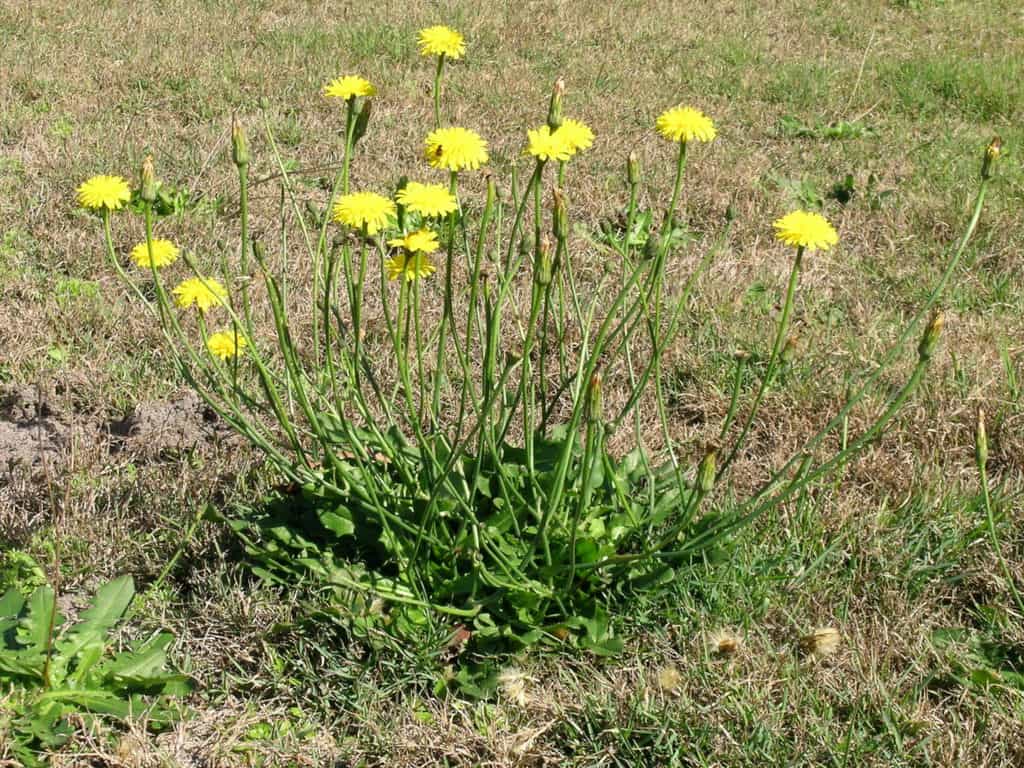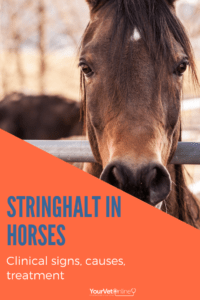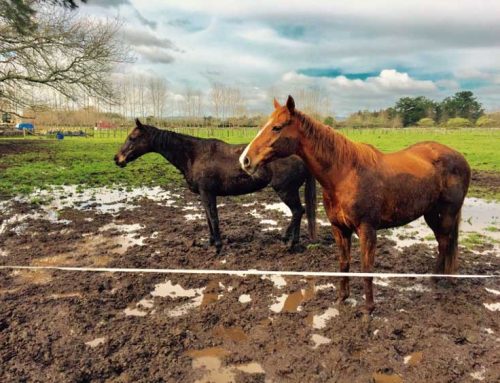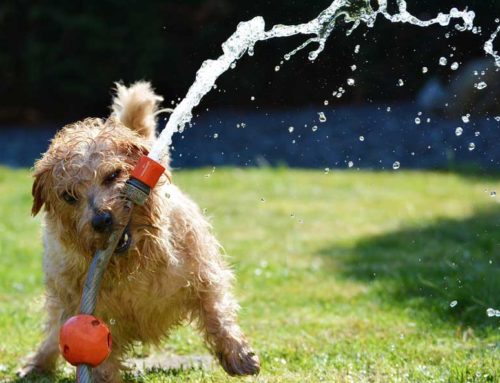Stringhalt In Horses: Causes And How To Treat
[easy-social-share]
Is your horse lifting a hindlimb in an unusual way when walking, trotting or backing?
Your horse could be suffering from a condition known as Stringhalt.
Stringhalt (Equine reflex hypertonia) is described as a non-painful neuropathic condition of horses that is characterised by an abnormal hindlimb gait.
It is easily recognisable because the horse will tend to lift and maintain the hindlimb in excessive flexion and kind of ‘jump forward’ and slam it down.
Stringhalt is most obvious when a horse is walking forwards and backward and in many cases will disappear at higher speeds.
This condition can be caused by the ingestion of toxic plants as well as injuries to specific muscles.
Read on to learn what plants to be on the alert for in your pasture and what to do if your horse develops this condition.
Signs Associated With Gait
Stringhalt tends to affect horses more severely affected at the walk, and as the gait increases in speed, clinical signs disappear.
This is why the development of this musculoskeletal disorder in a dressage horse might end a career, yet in a show-jumper, racehorse or barrel racer the effects may be minimal if any.
Some horses are affected in both hind legs, while others may only be affected in one hind limb.
The hindlimb lameness associated with stringhalt could be described a little like “goose-stepping”.
This high stepping hind leg gait is due to excessive hypermetria and hyperflexion of the stifle and hock.
Sometimes, these horses may hit their belly with their hoof and ‘bunny hop’ along when walking.
When examining a horse or pony with suspected stringhalt, backing the horse can noticeably increase clinical signs making it easier to diagnose.
In very severe cases where segmental demyelination of nerves of the hind legs has caused peripheral neuropathy, neurogenic muscle degeneration may occur and we will see atrophy of hindlimb muscles such as the gaskin and/or rump.
Respiratory Signs
Stringhalt caused by consumption of Flatweed can result in other neuropathies such as laryngeal paralysis.
Causes Of Equine Stringhalt
Scientists and veterinary researchers still are unable to tell us exactly what stringhalt in horses is caused by, however, there does appear to be two types of stringhalt in horses:
- True (idiopathic) stringhalt and
- Sporadic, or pasture-associated stringhalt – often known as Australian stringhalt
Causes Of True (Classic) Stringhalt
True (some may call it Classic) stringhalt is one of those conditions that has scientists scratching their heads.
Cases often occur in older equine patients, and frequently affects only one hindlimb.
There doesn’t appear to be any breed or activity links or a relationship to nutrition or environment.
The only hint of a cause for True Stringhalt is there may be evidence of an injury to the lateral digital extensor tendon or dorsum of the metatarsus (front of the cannon).
Plants That Cause Stringhalt In Horses
In contrast, sporadic or pasture-associated stringhalt appears to be associated with consumption of False Dandelion (Flat Weed, Catsear), while the common dandelion (Taraxacum officinale) is non-toxic to equines,
Although Flatweed (Hypochaeris radicata or Hypochoeris radicata) is native to Europe, it is commonly found all over the world.
In the US this plant is often found in California, South Carolina and Washington State, and it is everywhere in Australia and New Zealand.
Flatweed is common in most lawns, large paddocks, waste and disturbed soils and areas prone to drought and poor soil nutrition.
True Dandelion in contrast, requires moist soils and tends to be found more in lawns and around areas that have plenty of water.
One quick way to tell the difference between Flatweed and True Dandelion is to check the flower stems.
Dandelion has one stem, while Flatweed has branched flower stems with multiple flowers.
We often see cases of this type of stringhalt in an outbreak situation where many cases suddenly appear, usually associated with a distinct seasonal pattern.
The most common times we see this in Australia and NZ is at the end of summer early autumn when the first rains occur.
Often stock has been living in drought conditions with bare paddocks.
A little rain can see a flush of growth from these weeds and of course, horses and ponies will eat the plant quickly causing this subsequent health disorder!

Flatweed is common in drought-prone areas. If eaten it can cause Australian stringhalt in horses.
Treatment Of Stringhalt In The Horse
The treatment of stringhalt depends entirely on what we suspect caused the problem in the first instance.
Was it an injury?
Did it “just happen”?
Was the horse eating flatweed?
Treatment of stringhalt that is associated with an injury (i.e. it is often only affecting one hind leg) and not related to Flatweed toxicity may be able to be treated with surgery.
Lateral Digital Extensor Tenotomy
This equine surgery can be performed standing under local anaesthetic or in recumbancy under general anaesthetic.
A portion of the lateral digital extensor tendon that crosses the lateral surface of the hock joint is removed.
Two incisions are made, the first is over the muscle belly of the lateral digital extensor just above the level of the point of the hock.
The other is at the distal end of the lateral digital extensor tendon just before it joins the tendon of the long digital extensor.
The tendon is pulled out through the upper incision and about 15cm is removed.
After suturing the subcutaneous tissues and skin the area is bandaged.
Rehabilitation-wise, it is important that the horse is kept active after the surgery. Plenty of trotting exercise can help to improve the success rate of this surgery.
Treatment Of Australian Stringhalt Caused By Flatweed
At the first glimpse of symptoms of stringhalt caused by the consumption of flatweed, it is vitally important that the horse is removed from incriminated pasture.
For some horses, recovery with just removal from pasture may be very quick, while for others recovery can take months to years.
There are many opinions floating around about what the best treatment is for Australian stringhalt, but the key comes down to the following:
- Decontamination
- Use of anti-oxidants
- Phenytoin
- Vit B Complex
- Magnesium
Decontamination
The first part of any treatment of Stringhalt is to remove the horses from the source of flatweed.
You can put them in another paddock or yard/stable.
The key is to ensure that there is no access to any pasture or hay that contains this weed.
Make sure that there is no flatweed in hay
You might need to decrease the amount of feed if your horse is affected badly enough that you can’t exercise them.
You don’t want them bursting their seams!
Some veterinarians will advise decontaminating to try to ‘flush the system’ by giving laxatives.
The idea behind this is to get as much of the weed out of the gastrointestinal system as fast as possible to prevent absorption.
We can do this by using Magnesium salts.
Because we don’t know the exact mechanism of toxicity, some will also recommend use of a mycotoxin binder.
Evidence is lacking that mycotoxins are a factor in the disease process so we cannot recommend this.
Antioxidants
Vitamin E and Vitamin C have antioxidant properties that may help to repair peripheral neuropathy by scavenging free radicals.
Again, there is little evidence to suggest that this occurs in this disease process making this recommendation questionable.
Phenytoin
A study by PJ Huntington in 1991 on the Use of Phenytoin to Treat Horses with Australian Stringhalt showed that 15 mg/kg of phenytoin given with feed every 12 hrs for 2 weeks helped to improve clinical signs of stringhalt.
Phenytoin is an anti-epileptic medication (centrally acting anti-convulsant) that hyperpolarises the nerve membrane so that the potential threshold is increased and decreases the action potential peak thereby reducing clinical signs i.e. firing of the nerves is dampened.
It may help to minimise clinical signs, however, this is not ‘treating’ the cause as such.
Vitamin B Complex And Magnesium
In humans, peripheral neuropathies can be due to a deficiency in Vitamin B, in particular thiamine (B1). There is no evidence in horses that this treatment is of benefit. If clinical signs do improve it is likely due to improving clinical signs, not improvement of the peripheral neuropathy.

Can Stringhalt In Horses Be Cured?
The prognosis of recovery for horses with stringhalt can be regarded as fair.
Full recovery can occur, but it can take anywhere from 2 weeks to 2 years.
For this reason, prevention is better than cure.
Prevention of Stringhalt
Aside from keeping your horse wrapped in cotton wool to prevent injury, at this point in time we don’t know how to prevent True Stringhalt.
When it comes to Australian Stringhalt (caused by consumption of Flatweed) we can do more.
It is very important to assess your paddocks for signs of flatweed and remove this immediately.
Perform regular weed inspections of your paddocks especially following a dry season and a period of rain.
Similar Hindlimb Lameness: Stringhalt Vs Fibrotic Myopathy
Another condition of the back legs that causes a slapping down of the hoof is fibrotic myopathy.
Fibrotic myopathy is a type of mechanical lameness where hindlimb movement is restricted by mechanical limitation due to injury and scarring of the hamstring muscles (semimembranosus, semitendinosus).
The horse is unable to physically extend its leg forward.
Surgical transection of the scar or the tendon below using standing anaesthesia is the treatment of choice, with good return to function.
Has your horse has experienced stringhalt? We’d love for your to share your experience in the comments below. How long did it take for them to recover?
You May Also Like
How To Treat Wounds And Prevent Proud Flesh In Horses
[easy-social-share]





We “adopted” a mammoth donkey January 2019. He was extremely under weight and so depressed he wouldn’t eat. He couldn’t lie down. He had very thin dry hair with sores on his back. His tail is oddly short, his neck has a fatty flopped over crest, and he has what seems to be string halt on both back legs.
We finally convinced him to eat by literally hand feeding soft beet pulp and oats behind his big lips. He’d lick teeth and soft food and swallow but didn’t eat from bowl for over a week.
He wasn’t able to lay down until 5 months of feeding and walking. Once he began to lay down he developed wounds on front of both hocks. The wounds required daily care. They eventually healed.
Four years later he’s a happy donkey with shiny fur and a healthy appetite. He still seems to have bilateral string halt and trips a lot. His voice is what I call a whisper. He has a bony top line and rump with a roundish belly.
He recently developed another wound on front of one hock. Both hocks seem swollen and warm.
I’d appreciate any wisdom or guidance I can get on managing his weird condition.
Last week we had stringhalt surgery performed on my 12 year old paint mare who had a severe leg injury when she was one year old. I got her as a rescue, trained her, rode trails, chased cows and did normal things. She had a funny gate and rough trot but a wonderful rocking chair lope. About 8 months ago she ran through a fence and then flipped violently over the wire fence and landed on her bad leg. Stringhalt got really bad after that. Surgery was about $1400 which included hospital stay for 5 days. She is doing great now. One who didn’t know would not guess she had it a bad case. It has been 2 weeks and still stalled but she is walking all over and seems great. Can upload pictures if requested.
That’s great to hear that she is doing well.
I just recently bought a horse that I think has stringhalt.
Nothing showed up on a prepurchasE exam.
I was told that he does hike his hind leg up sometimes but it is mitigated with massage and acupuncture.
He just started doing it a couple of weeks ago. It is intermittent. Disappears at the trot and canter and doesn’t show up when I turn him under saddle at the walk.
I have noticed on the affected leg on the rump a small atrophy that is very hard. When I pushed on it he hiked his keg.
I bought him as a dressage horse. I’m really worried.
I’m in the US
Oh Linda that isn’t good.
It would be worthwhile having your vet examine as PSSM can also mimic stringhalt.
My horse developed a sudden severe stringhalt which I believe was caused by eating false dandelion. Once removed from that paddock she began to recover and signs disappeared completely within about 6 months. After that she had a tendency to fall onto her knees while being ridden, once actually hitting her face on the ground before recovering, but she was 20 years old by then so it may have been age related.
My QH gelding developed stringhalt after a severe injury to the front of his cannon bone. About 5″ of the leg was degloved and the extensor severed. It frustrating that there’s very little info out there about this condition. This is the first time I’ve seen that specific injury mentioned as a cause (“The only hint of a cause for True Stringhalt is there may be evidence of an injury to the…dorsum of the metatarsus (front of the cannon).”). Interesting. Is there a source for this? My gelding’s stringhalt seems better on some days than others. We’re about 8.5 months post injury, but the wound isn’t healed yet (it was massive). I’m hoping the stringhalt will improve with time.
Our horse has stringhalt for over 10 years. He has been doing well as most of his issue is when he backs up or turns. Four days ago he started holding his left rear leg up in the air and we have tried Bute and tonight some Ace but his pulse is going up and I am not sure if he will get better or not. I don’t understand why he has gotten bad so suddenly. We hope we can find something to calm this down, we hate to lose him.
Hi Linda
Apologies, we have only just seen your post. I hope you managed to solve the issue and your boy is doing ok. If not, I’m sad to hear.
If in future you were wanting advice, our vets are online 24/7, just hit “Start A Consultation” and it will take you through to the services page.
Take care.
Dr Leigh